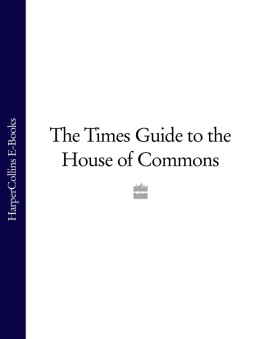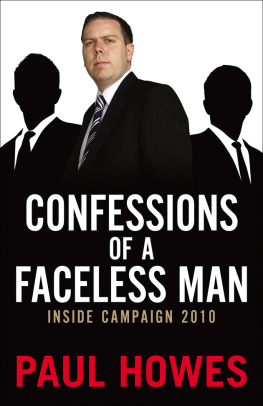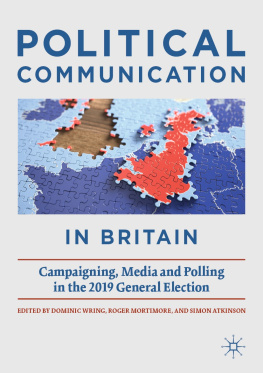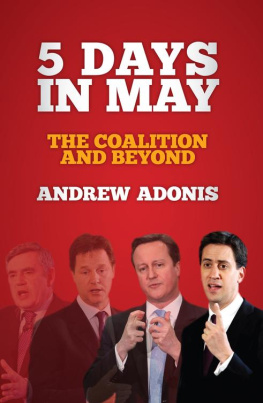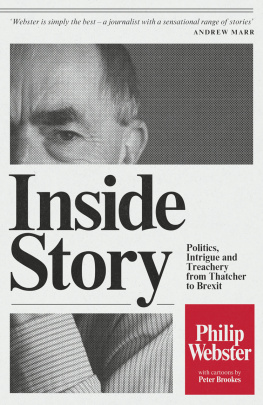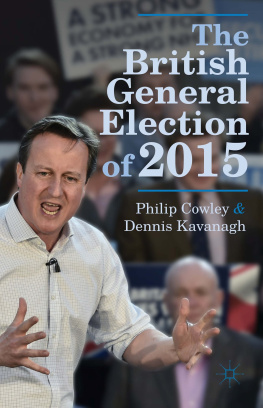Greg Hurst
Editor of the Guide
T he general election of 2010 was a watershed: the first since February 1974 at which no single party won an overall majority. The inconclusive outcome was accompanied by a strong sense of paradox. The Conservative Party won the most seats, 305, with one additional seat expected, and duly delivered, in the election in Thirsk & Malton that was delayed by the death of a candidate. And yet, by falling short of an absolute Commons majority, David Cameron was widely held to have failed to seize fully, particularly in the final year, the opportunity presented to him as the outgoing Government, and Gordon Brown in particular, became steadily more unpopular.
The Liberal Democrats, clear winners of the campaign itself, were stunned actually to suffer a net loss of five seats, bringing their tally down to 57. They had expected significant gains after the television debates propelled Nick Clegg into the living rooms of voters unhappy with Mr Brown but with nagging doubts about Mr Cameron. The ten-point jump in support for the Liberal Democrats after the first leaders debate was unprecedented in polling history. Even as the partys poll ratings began to glide downwards many Liberal Democrats hoped for, and expected, net gains of perhaps 20 or 30 seats.
The paradox was greatest within the Labour Party. Clear loser of the election, with a net loss of 90 seats, it endured its worst performance since 1931 during the Great Depression. Within Labour ranks, however, a grim sense of satisfaction was evident, even some pride, both at having clawed back from the prospect of being pushed into third place by the Liberal Democrats and at having denied Mr Cameron the majority that he wanted and, they may have calculated, he needed.
One refreshing aspect was that turnout, having reached a postwar low in 2001, rose again to 65.1 per cent, up by 3.7 per cent on 2005; if an election is interesting or the result uncertain, voters are more inclined to take part.
If the result appeared confusing to some, its immediate aftermath must have seemed doubly so. Gordon Brown, vanquished, returned to Downing Street. The Conservatives and Liberal Democrats, after weeks, months even, of fighting one another tooth and nail, dispatched teams to begin talks on a tentative arrangement for a minority administration or even a coalition. The outcome, Britains first coalition since Churchills cross-party administration during the Second World War, from 1940-45, and the first in peacetime since Ramsay MacDonalds National Government of 1929-35, and those that followed, ushered in a new era of British politics.
Coalition politics presents significant new challenges for the House of Commons. Ministers who are members of competing parties must find ways of working together that go beyond pragmatism and practical effectiveness and are based on trust, while maintaining their separate political entities and those of their parties. Backbench Members of both governing parties must find the language, tone and levers to criticise and influence individual aspects of policy or decisions of administration without tearing at the fabric of the coalition itself. There will be others unhappy about the very fact of coalition government, whose challenge is to advance their cause without being cast as wreckers. Such questions apply well beyond the exchanges on the floor of the Commons, to its select committees, public bill committees and its very culture as an institution.
For the Labour Party, in particular, the task of opposition carries heightened responsibilities. In the previous two Parliaments, the Liberal Democrats provided an increasingly significant alternative voice to that of the official Opposition, for example as the only British party to oppose the invasion of Iraq in 2003 and offering an alternative analysis during the financial crisis of 2008-09. Their entry into office gives the coalition Government an initial working majority in the Commons of 82 once the Speaker and Sinn Fin are excluded and leaves the main duty of opposition on Labours shoulders alone. Furthermore, the coalition will have, between its peers, a large majority over Labour in the House of Lords, where cross-benchers do not vote as a block. This is the first time a Government has commanded majorities in both Houses of Parliament since John Major in 1997, and makes the oppositions work of scrutiny and challenge in the Commons doubly important.
Gordon Browns resignation as Prime Minister and leader of the Labour Party heralded the opening of a new chapter for his party. Amid the uncertainty and fast-moving events of the post-election hiatus, this happened in two stages. First came an undertaking to step down at a future date if an alternative progressive coalition with the Liberal Democrats and minority parties could be negotiated. Then came his immediate departure as the coalition between Mr Cameron and Mr Clegg fell into place, although before its details were complete. Harriet Harman, Labours deputy leader, took his place temporarily as Leader of the Opposition as the party agreed to a timetable of more than four months to elect a new leader for its annual conference in late September.
Two parties are represented in the new House of Commons for the first time: the Green Party, 11 years after it gained two seats in the European Parliament, thanks to its method of election by proportional representation, and the Alliance Party of Northern Ireland. The United Kingdom Independence Party and British National Party polled substantially more votes than the Greens, and both improved their share of the vote, without winning seats. The trend of independent Members of Parliament, re-established by Martin Bell in 1997, was reversed in mainland Britain with the defeat of Richard Taylor in Wyre Forest, where he served two terms, and Dai Davies in Blaenau Gwent. It was maintained only by the presence of Lady Sylvia Hermon, who broke with the Ulster Unionists to retain her seat with a large majority. Her victory reflects the very different politics of Northern Ireland.
The outcome of the general election, inconclusive as it was, nonetheless captured the mood of Britain in the late spring of 2010: dissatisfied with Labour (other than in Scotland, the only part of Britain where the partys vote went up, and Inner London); attracted in significant numbers by Mr Cameron, although with doubts harboured by some and antipathy among a minority; restless for change; and disenchanted with politics and the excesses of the previous Parliament.
The most important dynamic for the Commons itself is the scale of the turnover of its Members. More than one third, 227, are new to Parliament. This is fewer than the 242 new MPs returned in 1997, a postwar record, but is a massive transfusion for an institution that had lost touch with what the electorate expected from it. At the election 149 MPs stood down of their own volition (or their partys) rather than face the voters again, far more than the 115 who did so before the end-of-era election of 1997. Five former MPs also return after periods of broken service.
The Times Guide to the House of Commons 2010 has itself undergone change. Its commitment to accuracy and balance remain, but with even greater emphasis on analysis and comment. Writers from The Times explore the wider undercurrents that had an impact on the voters view of politicians: the scandal of misuse of Commons allowances; the banking crisis and recession; and the handling of military campaigns in Iraq and Afghanistan. The Guide gives greater scope for the best of The Timess journalism beyond that of its writers, with the work of its photographers, illustrators, graphic artists and designers used to full effect.
Profiles of each Member of Parliament are livelier, intended to convey a sense of what each is like, what motivates them and how effectively they discharge their role, in addition to biographical details of what they have done. Information is included, too, on thousands of candidates who contested the election, were unsuccessful but attracted sufficient support to hold their deposit. Many among them, no doubt, will be the subject of fuller profiles in the next

